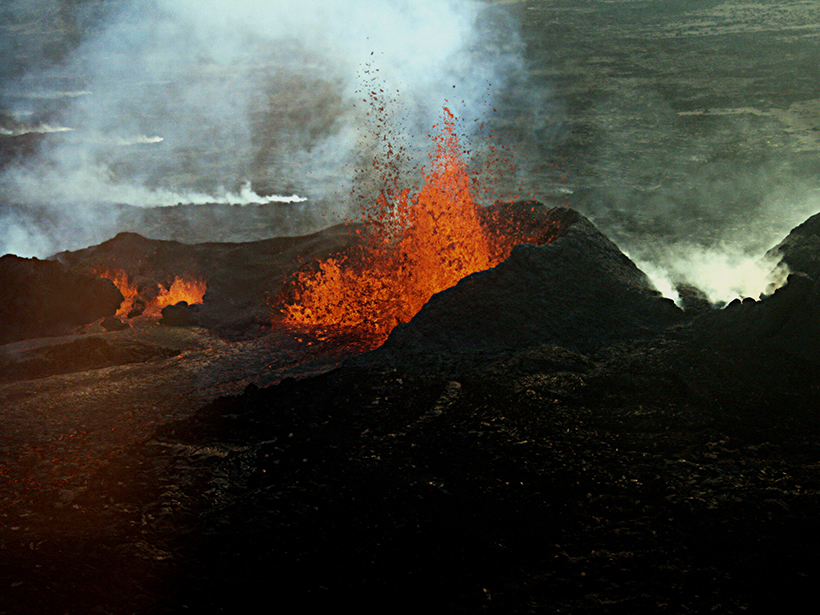Volcanic eruptions are just the tip of the iceberg: Hidden deep below ground, the preeruption behavior and movements of magma remain largely mysterious. Two new studies centered around a volcano in Iceland are shedding light on how long magma was stored deep underground and how long it took to travel to the surface before erupting, information that may be used to improve existing models of complex magmatic systems.
Geophysical monitoring methods can see only so deep beneath the surface of Earth, so to figure out what is happening deep inside a volcano, “you have to be a geological detective,” said Euan Mutch, an igneous petrologist at the University of Cambridge in the United Kingdom and lead author on both of the new studies, published in Science and Nature Geoscience.
The studies represent some of the first evidence of magmatic timescales for eruptions originating in the deep crust.
Mutch and colleagues at the University of Cambridge focused on the Borgarhraun eruption of Theistareykir, a volcano in northern Iceland, which took place around 10,000 years ago. Previous studies have shown the magma that fed this eruption came directly from the Mohorovičić discontinuity (the Moho), where Earth’s crust meets its mantle, at a depth of about 24 kilometers—far deeper than geophysical methods can see clearly.
To determine how long the magma was stored at the Moho before erupting, the team used a volcanic mineral called spinel as a crystal stopwatch.
“The elements in the crystal want to be in equilibrium with the surroundings,” Mutch explained.
As the elements equilibrate by diffusing out of the spinel, the mineral’s composition changes, creating a kind of crystal clock. Using known diffusion rates for aluminum and chromium, the team was able to determine how long the minerals were stored in the melt before it erupted, in this case about a thousand years, they wrote in Science.

In the Nature Geoscience study, Mutch and colleagues used a similar diffusion modeling technique on olivine crystals to show that the magma ascended from the Moho to the surface in as little as 4 days, at a rate of 0.02 to 0.1 meter per second.
The two studies represent some of the first evidence of magmatic timescales for eruptions originating in the deep crust at the Moho boundary, said David Neave, a petrologist at the University of Manchester in the United Kingdom who was not involved in either of the new studies.
“A lot of progress has been made understanding timescales of shallower volcanoes, but these are the first studies to estimate how long magma is stored in the deep crust before it erupts,” Neave said. “That’s crucial new information.”
Diffusion modeling is not a new technique. The methods have been around for at least 10 years, Neave said, but Mutch and colleagues “were very clever in working out the uncertainties and arrived at much more precise estimates for these timescales than previous groups have been able to do.”
The findings also lend support to a growing body of research suggesting that magmatic systems can be much more complex than the textbook model of a volcano fed directly from a single bulbous magma chamber, said Stephen Sparks, a volcanologist at the University of Bristol in the United Kingdom who was not involved in either of the new studies.
“Their results contribute to the evidence that supports vertically extensive transcrustal magma systems,” Sparks said. The study does not introduce any fundamentally new concepts but “supports this emerging new paradigm. The paper is amongst the most thorough and convincing published so far.”
Applying the Techniques to Other Volcanoes
Whether the 1,000-year timescales for magma storage and mere days of travel to the surface are typical of other volcanoes or unique to Theistareykir is unknown, Mutch said. The next steps will be to apply the same diffusion modeling techniques to other eruptions.
Crystal clocks can be used at a variety of volcano types, not just the basaltic volcanoes found in Iceland, Neave said.
“I think this approach will prove to be widely applicable to a range of volcanic settings.”
“Most volcanoes are ultimately underlain by basaltic materials, even if they’re erupting rhyolite or andesite at the surface like at the Cascades volcanoes [in the United States],” he said. “I think this approach will prove to be widely applicable to a range of volcanic settings.”
The findings may ultimately aid in developing more accurate magmatic and eruption models as well as improving volcanic hazard forecasts, Mutch said. The Nature Geoscience paper in particular showed a link between the magma’s rate of ascent and the release of carbon dioxide, which could be used to predict an impending eruption.
“At the ascent rates estimated for the Borgarhraun magma, an increase in carbon dioxide flux at the surface would only be detected at most 2 days before the eruption,” Mutch said. However, other volcanic systems may offer more lead time: “This threshold will be different for magmas with different carbon contents and that are stored at different depths before eruption.”
—Mary Caperton Morton (@theblondecoyote), Science Writer
Citation:
Morton, M. C. (2019), Crystal clocks serve as stopwatch for magma storage and travel times, Eos, 100, https://doi.org/10.1029/2019EO130469. Published on 12 August 2019.
Text © 2019. The authors. CC BY-NC-ND 3.0
Except where otherwise noted, images are subject to copyright. Any reuse without express permission from the copyright owner is prohibited.

